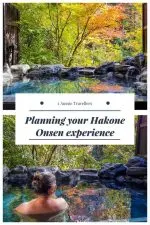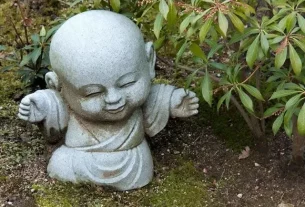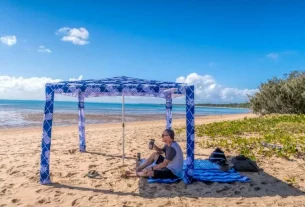Soaking in a Hakone onsen is a truly blissful experience that we highly recommend. It really is the ideal blend of Japanese culture, nature and perfect relaxation. Hakone is only one of the onsen regions in Japan but it’s conveniently accessible from the high-speed train line between Tokyo and Kyoto.

Hakone is one of Japans best known and most loved onsen resort destinations. It’s been that way for centuries with several groups of onsen all around Hakone including Hakone Yumoto and Lake Ashi located along the old Tokaido route. Tokaido was the busiest of the 5 historic routes in and out of Tokyo during the Edo period, many feudal lords and their entourage would have been required to make at least an annual visit to Tokyo (Edo) passing through the town and the Hakone Checkpoint.
Today Hakone is a destination in its own right not just a stop on the journey and the geothermal activity and resulting proliferation of onsen play a large part in its popularity with domestic and international visitors.
Table of Contents
What is an onsen
Onsen is the Japanese term for what we might call hot pools or hot springs in the west. More specifically they are only called onsen when the heated water comes from a naturally heated hot spring under the ground. The water may be cooled to a usable temperature with the addition of cold tap water but all the heat is natural. The onsen may take either the form of a bathhouse or it may be an outdoor pool or spring.
The mineral composition, healing properties and reactions that cause the heat to build up and come to the surface are many and varied. Japan, like New Zealand, is a heavily volcanic country and not surprisingly there are a great number of onsen congregated in areas where that activity is most concentrated like Hakone.
A sento is a bathhouse too but the water is heated tap water, therefore while soaking, relaxing and the social aspects of sento may have their own healthy aspects a sento doesn’t have the same healing qualities that are associated with the minerals of an onsen.
The history of onsen in Japan
When you visit an onsen today it’s normal for them to be segregated, that is men and women bath communally but separately. It wasn’t always that way, in fact, historically onsen were always mixed and stayed that way until Japans isolation ended during the Edo period. In the 1950s under American occupation, Japan passed a law until then considered ridiculous, requiring the segregation of onsen by gender.
The change wasn’t as black and white as it appears though, it wasn’t something that could be done overnight, many places had one bath and everyone needed to use it so the rules prevent new kon-yoku or mixed onsen from opening and required that once the bathhouse had been segregated, it could not revert back. In addition, some cities, such as Tokyo, subsequently issued an outright ban on public mixed bathing.
Today it’s very rare to find a kon-yoku and you aren’t likely to stumble into one especially in the cities. There are some that still exist though and I came across two examples on a recent visit to Aomori in the north of Honshu. The first is the healing waters of the historic Sukayu with its renowned “1000 person bath” pictured above and the second the stunning outdoor pool of Yaekokonoe no Yu at the foot of the Kokono-e Waterfall in the Oirase Gorge.
Did you know Japanese monkeys love the onsen too?
Societies around the world have understood the therapeutic powers of hot springs and social benefits of communal bathing since ancient times but in Japan was the first time I had seen the same type of bathing routine by animals.
Have you heard of wild Japanese monkeys, or macaque, soaking in an outdoor onsen in the forest? This really does happen but not in Hakone. The only place I have seen it or heard of it happening is at Jigokudani Park in the north of Nagano prefecture.
It’s natural behaviour of wild animals and well worth seeing if you ever have the opportunity, I’ve previously written about how to make the trip to the snow monkeys from Tokyo or you can do it as part of an organised tour.
The macaques have lived in the area known for its natural thermal springs for a long time. In the 1960s locals noticed that the monkeys would find a rock crevice with a natural spring and bathe in it. Before long the monkeys also noticed that the local humans had outdoor springs that were much bigger and more comfortable for them to soak in.
Not surprisingly the locals and tourists quickly outgrew the novelty of sharing their own bathwater with monkeys and grew tired of chasing them off. To resolve the issue they expanded one of the monkeys natural springs in the park so it was filled with hot spring water all year round. The snow monkeys have stayed in the area year-round ever since.
A look inside a Hakone onsen resort
On our autumn colours trip along the Golden Route, we knew we had to include an onsen day at Hakone, a long-standing stop on that route dating back to the Edo period. We weren’t going to be able to add an extra night so included it as a day trip out of Tokyo.
I had done my research in advance and knew we wanted to book and travel independently rather than joining a tour. This meant I narrowed my choice considerably to select an onsen resort with excellent reviews, an English language website and bookings also available in English.
Once we had settled on Hakone Yuryo we also decided to treat ourselves to one of their private onsen rooms where we would be able to enjoy the onsen experience together. There are 19 private rooms which are booked for one hour and can be extended on request.
We booked a ‘type 3’ room which was a bit of a splurge at Y6000 but we were very happy with our choice and highly recommend the relaxing experience of a private room as a couple or family. Although we initially thought the hour might be too short we found it was the perfect amount of time to complete the ritual process, be thoroughly relaxed and dress again without being rushed or stressed.
There are also communal baths at Hakone Yuryo. These baths are gender separated and include both outdoor pools set in beautifully maintained gardens and an indoor option. These pools and the private ones are maintained at 40°C with the addition of cool water as required. There are also individual tubs to soak and a cold plunge pool (14°c) if you are so inclined. The facility also offers relaxation massage and sauna facilities.
When you are done with the onsen or between uses there are relaxation spaces, a restaurant and a kiosk where you can purchase cool drinks and ice creams to enjoy in the outdoor seating with a lovely view of the gardens.
Getting to Hakone Yuryo Onsen
We were staying at the Tokyo Park Hotel in Shiodome, a central spot with several subway and train stations in close proximity. Rather than making the additional stop and navigating our way through the morning crowds at Tokyo station to use the bullet train we took the JR Tokaido line direct from Shimbashi.
This is a local train and we left early enough to avoid the worst of the crowds on the way there. Coming back relaxed from our day of onsen soaking and anticipating the trains being fairly busy in the peak evening hours we paid the extra (around A$10) supplement for the green car.
This gives seating in 2×2 configuration seats similar to the shinkansen, together with our snacks and drink it made the 70-minute trip back very comfortable, I wouldn’t hesitate to pay for the supplement again, it was money well spent.
The Tokaido line, like the bullet train, stops at Odawara station in Hakone. From here we took the Tozan train as far as Hakone-Yumoto, if you’re using the romance train from Shinjuku it takes you directly to Hakone-Yumoto station. Your choice will probably depend on what part of Tokyo you’re staying in.
From here it’s very easy. Exit through the station gates, past the shops and down the stairs at the far end. There will either be a small bus there already waiting or it will be along very shortly, it completes the circuit every 10-15 minutes.
The shuttle bus service is free and takes you right to the door of the onsen and back to the station again in line with their published timetable. If you have time you can walk but it’s up a steep hill without footpaths or much else to see along the way. You may prefer to walk through the town or along the river to the temple and waterfalls when you get back to the station.
Making a booking at Hakone Yuryo
One reason we chose Hakone Yuryo, in addition to its position and reputation, was the ease of making a booking for non-Japanese speakers. You only need to book if you want a private room on a specific date and time, however if making the trip to Hakone with the intent of using the public onsen it might still be worth a short email to confirm that the onsen will be open on your chosen date.
Hakone Yuryo address: 4 Tonosawa, Hakone-machi, Ashigarashimo-gun, Kanagawa Prefecture 250-0315
Their website includes an English section with contact details for email inquiries and bookings.
Understanding onsen etiquette
The rules for using an onsen are based on centuries of tradition and what is considered appropriate behaviour. The rules are quite simple and nothing to be concerned about but it is good to know the basics in advance.
- No swimsuits or other clothing – the onsen is for bathing not swimming, you get into the water naked.
- Don’t dip your towel – nothing goes into the onsen water but you. You will have 2 towels, leave the large one somewhere dry, the small one is to wipe your face or protect some modestly when moving around, it can be left on the side of the pool within reach. That small towel is tiny though, you’re going to have to be selective about what modesty gets protected.
- Use the shower facilities to wash thoroughly before entering the onsen, if you leave at any time, to go to the bathroom, for example, you are expected to repeat this step. Washing the body in the warm water before entering the pool also allows you to acclimatize a little to the hot water.
- Don’t splash in the shower area and rinse it down when you are done. The shower area will generally have a low stool to sit on, a showerhead and wooden bucket that you can fill and tip over yourself to rinse off the suds. They aren’t partitioned so don’t get too vigorous and tip it over the person next to you and when you’re done place the bucket to drain and rinse down the stool placing everything neatly again.
- Don’t wash in the onsen, it’s for relaxing not getting clean. Any soaping and shampooing is done in the shower area first and should be thoroughly rinsed off.
- Tie up your hair if it is long, it should not touch the water.
- It goes without saying but don’t stare at other bathers and don’t take photos in the onsen and dressing area.
Can I use an onsen with tattoos?
A well-known rule about bathing at the onsen is that most openly ban anyone with tattoos or gang affiliations. You need to understand the cultural history a little to understand that in Japan these two things are linked very closely together.
Most reputable onsens don’t make any exceptions although there are a few onsens that are targeted more to the tourist market that will. Whether it’s a tiny butterfly or full body art, it doesn’t matter, most places will not allow you to use the onsen if you have one.
Quite a few people have asked how to ‘get around’ the tattoo rule and really in the places we’ve used and researched you can’t. Even when you book a private onsen room when no one else is going to see or be offended you’re still asked to sign an agreement that includes a disclosure saying you have no tattoos on your body.
Some people have said to us that there are places that will allow you to use the facilities if it’s completely covered with a waterproof bandage or other places that have allowed them but I’ve not come across any and no one to date has been able to give examples of traditional onsen without the rule. If you know of any I would be interested to hear in the comments below.
How to use the onsen
- Before entering the changing area you should find lockers or storage cubes to place your shoes, remove them here and put on the guest slippers if they’re provided. Don’t forget to take your key from the locker if there is one.
- Enter the changing area, the noren (curtain) will show the kanji for men and women, they are often also colour coded or just ask at reception if you’re unsure.
- Select a locker, undress completely and leave your clothes in the locker. Take both your towels with you along with any toiletries to the wash area.
- Shower thoroughly mindful of conserving water as much as possible, you sit on the small stool to do this. Rinse away any remaining suds from the wash area when you are done and rinse the stool leaving the area clean and hygienic for the next person. Dry off a little so you aren’t dripping and tie or pin up your hair if it would otherwise touch the water.
- Covering yourself with the towel while you walk around is usual but creative maneuvers to position yourself into the water unseen are unnecessary and likely to draw more attention. Use the small towel to protect some modesty and then keep it either on your head or beside the pool next to you while in the water.
- When leaving the pool dry off as much as you can in the pool area before returning to the showers to avoid making a mess. Most onsen will have an area with mirrors, hairdryers and other items such as body lotion for your use.
- You may dress again at this point or perhaps you rented an onsen yukata on arrival for relaxing around the facilities. If so change into it now before moving through to the dining and relaxation spaces. These are generally communal spaces for men and women although some offer segregated relaxation spaces too.
Where to stay in Hakone
It’s relatively easy to make a day trip to Hakone from Tokyo. It takes only 35-75 minutes by train and services start early then run well into the night if you want to make a full day of it. To get the full Hakone experience though many will suggest you pack your overnight bag and book into a local ryokan or resort.
I’ve included a few tips below on choosing the best place to stay in Hakone and ensuring you get the most out of your overnight visit to the area.
1. Minimise your luggage. Most stays in Hakone are only for a night or two so a small bag is often enough. The transport in the area is an attraction in its own right but its local transport, it can be fairly crowded at times and is not designed for luggage. This is an ideal time to ask your hotel in your previous city to store your luggage or use a luggage forwarding service known as Takkyubin in Japan to forward it ahead to your next destination where it will be waiting for your arrival.
2. Selecting where to stay.
Deciding where to stay in Hakone can be quite difficult but some things to consider are:
- Do you want a property with an outdoor onsen, bathhouse or private in-room onsen? While there are some excellent onsen day resorts in the area putting on your yukata and going down to the one within your accommodation is a part of the Hakone experience.
- Is it important for you to be near the train station to drop off luggage and get on with exploring? Very few places offer a transfer service but the station and several of the attractions do have lockers to store bags you don’t need with you along the way.
- Do you want a ryokan with breakfast and dinner included? Or do you prefer a wide selection of restaurants nearby?
- What style of accommodation, traditional Japanese ryokan or an international property? If you’re planning to try a traditional room do you require a private bathroom, some of them are shared?
- Are there specific Hakone sights and attractions you want to be located near?
- And of course budget. Many properties in Hakone are on the pricey side it’s somewhere you stay for the experience or a short getaway rather than as a base for an extended stay. When comparing prices do note that some include 2 daily meals in that rate and use of the onsen facilities.
For our preferences, I would narrow it three areas of Hakone with a long history of onsen, either Hakone Yamote, Lake Ashi or Gora. If you’re using the Hakone Free Pass all of these areas can be accessed using the included transport as many times as you wish over the 2 day period.
There are some high-end accommodation options that offer onsen in the room. If these are out of your budget but you would like to onsen in private or with the family look for one that offers ‘kashikiri-buro’ these are family baths that you can book and then lock the door for privacy. You get all the benefits of a private in-room onsen but at a much more affordable price.
Find accommodation in Hakone
10 more things to do in Hakone
- Complete the circuit of Hakone sights and attractions by train, cable car, rope-way, boat, foot and bus. We discuss this in detail in two other articles on this site a day trip to Hakone and is the Hakone free-pass good value?
- Visit the Open Air art museum in Gora. If you don’t have a chance to visit another onsen on your trip you can try the foot onsen here, it’s free and unique Japanese experience.
- Take a cruise on Lake Ashi in a pirate boat
- Get an insight into what life would have been like in feudal Japan through the immersive displays and extensive recreations of barracks, walls and lookout towers at the Hakone Checkpoint museum
- Take in stunning views from the Hakone rope-way
- Eat a black egg cooked in a geothermal spring, they’re said to add 10 years to your life
- Follow the river in Hakone Yamote to Tamadare falls and Shogenji Temple
- Walk in the footprints of history along on a remnant of the old Tokaido Route
- Visit Hakone Shrine with its tori set out in the lake
- Explore the active volcanic valley of Owakudani

You might also be interested to read
As it’s not generally possible to take photos in communal onsen I have included a couple of photos in this post from @JNTO and their partners to give an idea of some of the styles of onsen available. Credits are included on the individual photos.











